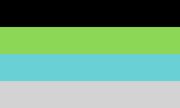(grammar and spelling mistakes) Tags: Visual edit apiedit |
No edit summary Tags: Visual edit Mobile edit |
||
| (23 intermediate revisions by 12 users not shown) | |||
| Line 1: | Line 1: | ||
| − | '''Quoiromantic''' |
+ | '''Quoiromantic''', also known as '''WTFromantic,''' is an alternative to a [[romantic orientation]] label. |
| + | The originator of the ''quoi-'' prefix, Cor, defines being quoiromantic as 1) not understanding or actively disidentifying with romance/romantic attraction/romantic orientation as sensible/applicable categories, personally, or 2) feeling that these categories are personally inaccessible, inapplicable, or non-sensical.<ref>[http://epochryphal.tumblr.com/post/106762907052/a-note-on-quoi A Note on Quoi-]</ref> The premise of the ''quoi-'' identity challenges the idea that these concepts are universally applicable and relevant.<ref>[http://epochryphal.tumblr.com/post/112951589957/quoi-is-not-cant-tell Quoi- is NOT “can’t tell”]</ref> |
||
| − | It is described as: |
||
| ⚫ | |||
| ⚫ | |||
| ⚫ | |||
| ⚫ | |||
| ⚫ | |||
| − | * Struggling to find a better term because it is too complicated or because they just don't fit any other term |
||
| − | * Not experiencing romanticism in a traditional manner |
||
| ⚫ | <p style="margin-top: 1.35em; margin-right: 0px; margin-bottom: 1.35em; margin-left: 0px; padding-top: 0px; padding-right: 0px; padding-bottom: 0px; padding-left: 0px; border-top-width: 0px; border-right-width: 0px; border-bottom-width: 0px; border-left-width: 0px; border-style: initial; border-color: initial; outline-width: 0px; outline-style: initial; outline-color: initial; font-weight: inherit; font-style: inherit; font-size: 1em; font-family: inherit; vertical-align: baseline; line-height: 1.5; text-align: justify;"> |
||
| + | Quoiromantic experiences may include: |
||
| − | <p style="margin-top: 1.35em; margin-right: 0px; margin-bottom: 1.35em; margin-left: 0px; padding-top: 0px; padding-right: 0px; padding-bottom: 0px; padding-left: 0px; border-top-width: 0px; border-right-width: 0px; border-bottom-width: 0px; border-left-width: 0px; border-style: initial; border-color: initial; outline-width: 0px; outline-style: initial; outline-color: initial; font-weight: inherit; font-style: inherit; font-size: 1em; font-family: inherit; vertical-align: baseline; line-height: 1.5; text-align: justify;">Other terms that are similar are gray/grey-(a)romantic, idemromantic, platoniromantic, quasiromantic, and alterous.</p> |
||
| ⚫ | |||
| ⚫ | |||
| ⚫ | |||
| ⚫ | |||
| ⚫ | |||
| + | * Questioning romanticism for such a long time that the questioning itself becomes the identity, rather than a path toward any other more stable identity |
||
| + | * Struggling with romanticism because it feels too complicated |
||
| + | * Simply not feeling that any other romantic orientation label is applicable |
||
| + | |||
| + | [[File:Bdb58c0e6131e8e447bbcd43bfff2aeb3a53edd1 hq.jpg|thumb|Commonly used Quoiromantic flag]] |
||
| + | [[File:QuoiSpiralQ.png|thumb|The spiral Q, a symbol of Quoi]] |
||
| + | Other terms that are similar to quoiromantic include [[gray-romantic|grayromantic]], [[nebularomantic]], [[idemromantic]], [[platoniromantic]], and [[quasiromantic]]. |
||
| + | |||
| + | == Surveys == |
||
| + | It is unknown how many people identify with quoiromanticism outside the asexual community. However, the results of the 2016 asexual community census showed that 9.5% of ace respondents identify as quoiromantic or wtfromantic.<ref>Bauer, C., Miller, T., Ginoza, M., Guo, Y., Youngblom, K., Baba, A., Penten, P., Meinhold, M., Ramaraj, V., Ziebert, J.,Trieu, T., Adroit, M., (2018). [https://asexualcensus.files.wordpress.com/2018/11/2016_ace_community_survey_report.pdf The 2016 Asexual Community Survey Summary Report]. The Asexual Community Survey Team.</ref> |
||
| + | |||
| + | In 2019, an informal survey asked respondents to finish the sentence "For me, the distinction between romantic & nonromantic is..." according to a 5 point scale: 1 for Unclear, 5 for Clear. Out of those who checked off "quoiromantic" or "wtfromantic" as terms they would use to describe themselves (N=319), 45.8% answered 1 (Unclear), 37% answered 2, 10.7% answered 3 (Neutral), 5.6% answered 4, and 0.9% answered 5 (Clear).<ref>[https://www.pillowfort.social/posts/803837 Romantic Ambivalence Survey: Data by Subgroup - WTF/Quoi]</ref> |
||
| + | |||
| + | == History == |
||
| + | As a consequence of the romantic orientation model becoming popular in the [[Asexual spectrum|asexual]] community in the 2000s, some asexual people began to openly discuss why the model did not feel right for them.<ref>[https://theacetheist.wordpress.com/2019/01/04/quoiro-wtfromantic-a-brief-timeline-of-disidentification-with-personal-rejection-of-romantic-orientation/ Quoiro/WTFromantic: a brief timeline of disidentification with & personal rejection of romantic orientation] |
||
| + | </ref> For example, Kaz wrote that for them, asking "so what's your romantic orientation?" is "the wrong question."<ref>[https://kaz.dreamwidth.org/238564.html A/romanticism]</ref> In 2011, in order to express frustration with the system, Sciatrix began half-jokingly referring to herself as "wtfromantic" (as in "what-the-fuck-romantic").<ref>[https://writingfromfactorx.wordpress.com/2011/05/22/writhing-in-the-throes-of-unrequited-like/ Writhing in the Throes of Unrequited Like] |
||
| + | </ref><ref>[https://writingfromfactorx.wordpress.com/2011/11/26/a-set-of-affections-difficult-to-characterize/ A Set of Affections Difficult to Characterize] |
||
| + | </ref> In her words, "it started as a flippant, honestly fairly sarcastic frustrated comment, not an attempt as a serious identity designation," one she did not expect to resonate with other people and begin to proliferate.<ref>[https://writingfromfactorx.tumblr.com/post/86380040349/ultraviolet Ultraviolet]</ref> As a more pronounceable alternative, quoiromantic was proposed by Cor in 2012.<ref>[https://epochryphal.tumblr.com/post/37572886173/a-thought-wtfromantic-is-a-very-important A thought]</ref> Both terms are still in use today. The premise of the quoiromantic identity has also spread to other areas of identity, resulting in terms such as quoisexual, [https://epochryphal.tumblr.com/post/91335142632/wait-shit-the-obvious-word-coinage-quoigender quoigender], and [https://solipsistful.tumblr.com/quoigenic quoigenic]. |
||
| + | |||
| + | == Symbolism == |
||
| + | [[File:CorsQuoiFlag.png|thumb|207x207px|Cor's original flag design, edited to add the intended transparency ]] |
||
| ⚫ | <p style="margin-top: 1.35em; margin-right: 0px; margin-bottom: 1.35em; margin-left: 0px; padding-top: 0px; padding-right: 0px; padding-bottom: 0px; padding-left: 0px; border-top-width: 0px; border-right-width: 0px; border-bottom-width: 0px; border-left-width: 0px; border-style: initial; border-color: initial; outline-width: 0px; outline-style: initial; outline-color: initial; font-weight: inherit; font-style: inherit; font-size: 1em; font-family: inherit; vertical-align: baseline; line-height: 1.5; text-align: justify;">In 2015, Cor proposed a flag design for the quoi identity: four lavender question marks rotated in a ring to share a single dot, overlaid on a cool grey background in a house-shape, instead of the traditional rectangular flag.<ref>[https://epochryphal.tumblr.com/post/129602967777/ok-problem-solved-i-found-a-color-called-cool Cor's Quoiromantic Flag Proposal]</ref> Other flag design proposals have combined blue, green, black, and white or gray.<ref>[https://pride-color-schemes.tumblr.com/post/147022017775/quoi Quoiromantic Flag Designs]</ref> More recently, some simplified designs have been proposed inspired by the nontraditional flag shape idea, using a triangular flag shape instead.<ref>[https://queer-buccaneers.tumblr.com/post/185068311262/heres-an-idea-i-had-for-a-quoi-flag-thats-easier Simplified Quoi Flag Proposals]</ref></p> |
||
| + | == References == |
||
| + | <references /> |
||
[[Category:Romantic Orientations]] |
[[Category:Romantic Orientations]] |
||
Revision as of 21:51, 26 December 2020
Quoiromantic, also known as WTFromantic, is an alternative to a romantic orientation label.
The originator of the quoi- prefix, Cor, defines being quoiromantic as 1) not understanding or actively disidentifying with romance/romantic attraction/romantic orientation as sensible/applicable categories, personally, or 2) feeling that these categories are personally inaccessible, inapplicable, or non-sensical.[1] The premise of the quoi- identity challenges the idea that these concepts are universally applicable and relevant.[2]
Quoiromantic experiences may include:
- Being unsure if you experience romantic attraction or not
- Being unable to understand romantic attraction as a concept or feeling
- Finding the concept of attraction to be inaccessible, inapplicable, or nonsensical
- Being unable to pin down a clear understanding of romantic attraction, so being unable to say whether or not you experience it
- Having a difficulty distinguishing romantic attraction from other types of attraction, or being unable to distinguish them at all
- Questioning romanticism for such a long time that the questioning itself becomes the identity, rather than a path toward any other more stable identity
- Struggling with romanticism because it feels too complicated
- Simply not feeling that any other romantic orientation label is applicable

Commonly used Quoiromantic flag

The spiral Q, a symbol of Quoi
Other terms that are similar to quoiromantic include grayromantic, nebularomantic, idemromantic, platoniromantic, and quasiromantic.
Surveys
It is unknown how many people identify with quoiromanticism outside the asexual community. However, the results of the 2016 asexual community census showed that 9.5% of ace respondents identify as quoiromantic or wtfromantic.[3]
In 2019, an informal survey asked respondents to finish the sentence "For me, the distinction between romantic & nonromantic is..." according to a 5 point scale: 1 for Unclear, 5 for Clear. Out of those who checked off "quoiromantic" or "wtfromantic" as terms they would use to describe themselves (N=319), 45.8% answered 1 (Unclear), 37% answered 2, 10.7% answered 3 (Neutral), 5.6% answered 4, and 0.9% answered 5 (Clear).[4]
History
As a consequence of the romantic orientation model becoming popular in the asexual community in the 2000s, some asexual people began to openly discuss why the model did not feel right for them.[5] For example, Kaz wrote that for them, asking "so what's your romantic orientation?" is "the wrong question."[6] In 2011, in order to express frustration with the system, Sciatrix began half-jokingly referring to herself as "wtfromantic" (as in "what-the-fuck-romantic").[7][8] In her words, "it started as a flippant, honestly fairly sarcastic frustrated comment, not an attempt as a serious identity designation," one she did not expect to resonate with other people and begin to proliferate.[9] As a more pronounceable alternative, quoiromantic was proposed by Cor in 2012.[10] Both terms are still in use today. The premise of the quoiromantic identity has also spread to other areas of identity, resulting in terms such as quoisexual, quoigender, and quoigenic.
Symbolism

Cor's original flag design, edited to add the intended transparency
In 2015, Cor proposed a flag design for the quoi identity: four lavender question marks rotated in a ring to share a single dot, overlaid on a cool grey background in a house-shape, instead of the traditional rectangular flag.[11] Other flag design proposals have combined blue, green, black, and white or gray.[12] More recently, some simplified designs have been proposed inspired by the nontraditional flag shape idea, using a triangular flag shape instead.[13]
References
- ↑ A Note on Quoi-
- ↑ Quoi- is NOT “can’t tell”
- ↑ Bauer, C., Miller, T., Ginoza, M., Guo, Y., Youngblom, K., Baba, A., Penten, P., Meinhold, M., Ramaraj, V., Ziebert, J.,Trieu, T., Adroit, M., (2018). The 2016 Asexual Community Survey Summary Report. The Asexual Community Survey Team.
- ↑ Romantic Ambivalence Survey: Data by Subgroup - WTF/Quoi
- ↑ Quoiro/WTFromantic: a brief timeline of disidentification with & personal rejection of romantic orientation
- ↑ A/romanticism
- ↑ Writhing in the Throes of Unrequited Like
- ↑ A Set of Affections Difficult to Characterize
- ↑ Ultraviolet
- ↑ A thought
- ↑ Cor's Quoiromantic Flag Proposal
- ↑ Quoiromantic Flag Designs
- ↑ Simplified Quoi Flag Proposals